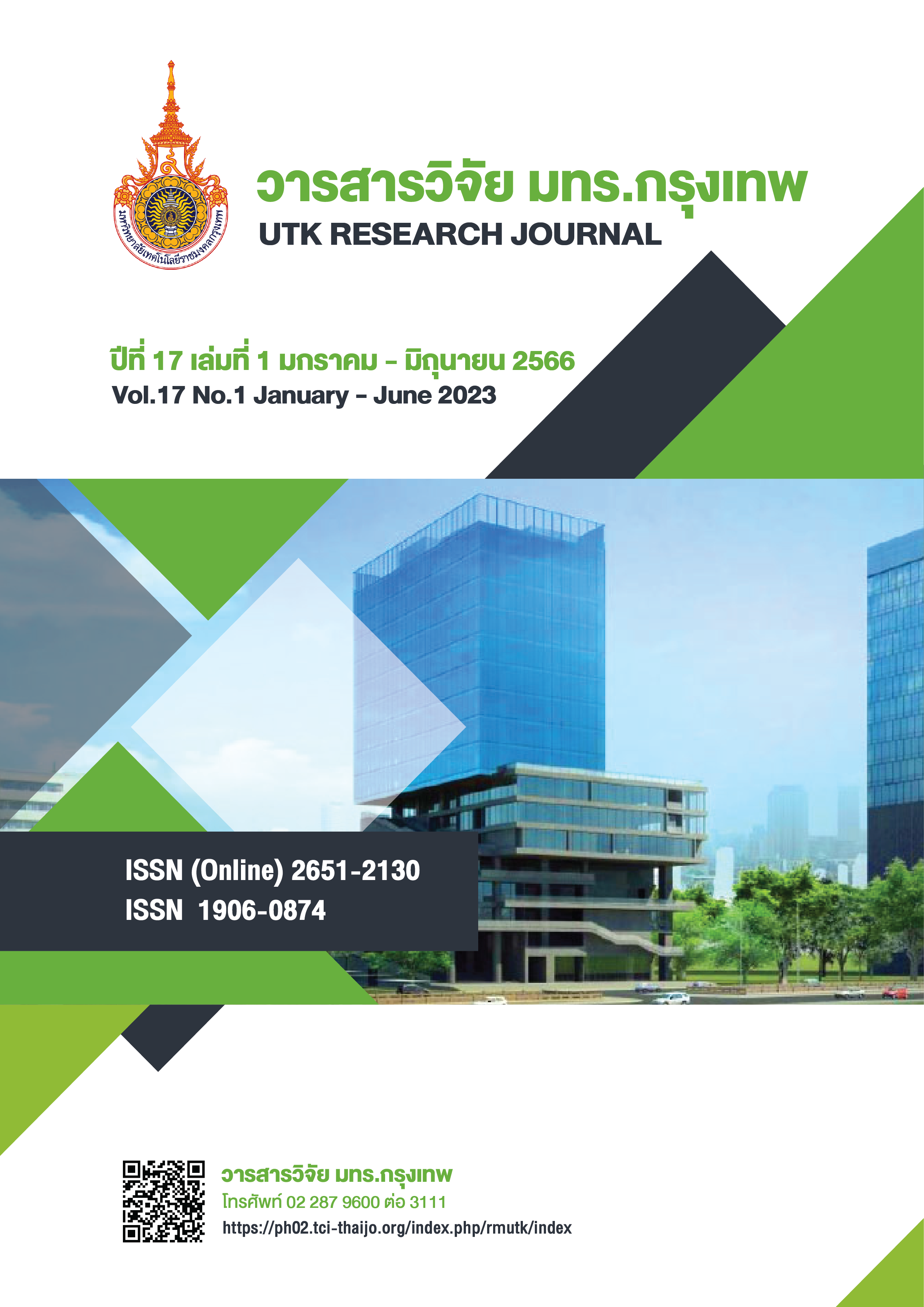ประสิทธิภาพการลดการปนเปื้อนของไกลโฟเสตในดินด้วยจุลินทรีย์คัดสายพันธุ์
Main Article Content
บทคัดย่อ
งานวิจัยนี้เป็นการศึกษาประสิทธิภาพการลดการปนเปื้อนของไกลโฟเสตในดินด้วยจุลินทรีย์คัดสายพันธุ์ ประกอบด้วย Pediococcus sp. Bacillus subtilis และ Bacillus licheniformis โดยในการดำเนินงานวิจัยจะทำการวิเคราะห์สมบัติทางกายภาพและสมบัติทางเคมีของดินที่นำมาใช้ในงานวิจัย จากนั้นวิเคราะห์ประสิทธิภาพการลดการปนเปื้อนของไกลโฟเสตในดิน ออกแบบการทดลองโดยแปรผันความเข้มข้นของไกลโฟเสตเพื่อติดตามความเปลี่ยนแปลง เป็นระยะเวลา 7 วัน จากนั้น เก็บตัวอย่างดินเพื่อไปวิเคราะห์ปริมาณของไกลโฟเสตด้วยเทคนิคแก๊สโครมาโตกราฟี (Gas Chromatography: GC) และนำมาคำนวณประสิทธิภาพการลดการปนเปื้อนของไกลโฟเสต จากผลการวิจัยพบว่า คุณสมบัติดินที่ใช้ในการวิจัยมีลักษณะเป็นดินเหนียว และค่าอินทรีย์วัตถุในดินตัวอย่างมีปริมาณ 26 กรัมต่อกิโลกรัม ซึ่งอยู่ในระดับปานกลาง โดยมีค่าพีเอช 6.58 ซึ่งเป็นกรดอ่อน ในส่วนการลดการปนเปื้อนของไกลโฟเสตนั้นพบว่า เมื่อใช้ปริมาณของจุลินทรีย์คัดสายพันธุ์ 10 กรัม และความเข้มข้นของไกลโฟเสต 240 มิลลิกรัมต่อกิโลกรัมนั้น จะให้ประสิทธิภาพการกำจัดไกลโฟเสตมากกว่าการใช้ความเข้มข้นของไกลโฟเสต 120 มิลลิกรัมต่อกิโลกรัม คือ ร้อยละ 91.69 และ ร้อยละ 90.81 ตามลำดับ ดังนั้น จากงานวิจัยนี้สามารถนำไปประยุกต์ใช้ในการจัดการไกลโฟเสตที่ตกค้างในดินที่เกิดขึ้นในภาคเกษตรโดยใช้จุลินทรีย์คัดสายพันธุ์ จากงานวิจัยนี้ได้อีกด้วย
Article Details

This work is licensed under a Creative Commons Attribution-NonCommercial-NoDerivatives 4.0 International License.
กองบรรณาธิการวารสารวิชาการ มหาวิทยาลัยเทคโนโลยีราชมงคลกรุงเทพ มีความยินดีที่จะรับบทความจากอาจารย์ นักวิจัย นักวิชาการทั้งภายในและภายนอกมหาวิทยาลัย ในสาขาวิชาวิทยาศาสตร์และเทคโนโลยี ได้แก่ สาขาวิชาวิทยาศาสตร์ วิศวกรรมศาสตร์ และสาขาอื่นๆ ที่เกี่ยวข้อง รวมถึงสาขาต่างๆ ที่มีการบูรณาการข้ามศาสตร์ที่เกี่ยวข้องวิทยาศาสตร์และเทคโนโลยี ที่เขียนเป็นภาษาไทยหรือภาษาอังกฤษ ซึ่งผลงานวิชาการที่ส่งมาขอตีพิมพ์ต้องไม่เคยเผยแพร่ในสิ่งพิมพ์อื่นใดมาก่อน และต้องไม่อยู่ในระหว่างการพิจารณาของวารสารอื่น
การละเมิดลิขสิทธิ์ถือเป็นความรับผิดชอบของผู้ส่งบทความโดยตรง บทความที่ได้รับการตีพิมพ์ต้องผ่านการพิจารณากลั่นกรองคุณภาพจากผู้ทรงคุณวุฒิและได้รับความเห็นชอบจากกองบรรณาธิการ
ข้อความที่ปรากฏอยู่ในแต่ละบทความที่ตีพิมพ์ในวารสารวิชาการเล่มนี้ เป็นความคิดเห็นส่วนตัวของผู้เขียนแต่ละท่าน ไม่เกี่ยวข้องกับมหาวิทยาลัยเทคโนโลยีราชมงคลกรุงเทพแต่อย่างใด ความรับผิดชอบด้านเนื้อหาและการตรวจร่างบทความแต่ละบทความเป็นของผู้เขียนแต่ละท่าน หากมีความผิดพลาดใดๆ ผู้เขียนแต่ละท่านจะต้องรับผิดชอบบทความของตนเองแต่ผู้เดียว
กองบรรณาธิการขอสงวนสิทธิ์มิให้นำเนื้อหา หรือข้อคิดเห็นใดๆ ของบทความในวารสารวิชาการ มหาวิทยาลัยเทคโนโลยีราชมงคลกรุงเทพ ไปเผยแพร่ก่อนได้รับอนุญาตจากกองบรรณาธิการ อย่างเป็นลายลักษณ์อักษร ผลงานที่ได้รับการตีพิมพ์ถือเป็นลิขสิทธิ์ของวารสาร
References
Gill JPK, Sethi N, Mohan A. Analysis of the glyphosate herbicide in water, soil and food using derivatising agents. Environ Chem Lett. 2017;15(1):85-100.
Zhang C, Hu X, Luo J, et al. Degeneration Dynamics of Glyphosate in Different Types of Citrus Orchard Soils in China. Molecules. 2015;20(1): 1161-75.
Singh S, Kumar VA, Gill JPK, et al. Herbicide Glyphosate: Toxicity and Microbial Degeneration. Int J Environ Res Public Health. 2020;17(20):7519.
Banks ML, Kennedy AC, Kremer RJ, et al. Soil microbial community response to surfactants and herbicides in two soils. Soil Ecol. 2014;(74):12-20.
Cassigneul A, Benoit P, Bergheaud V, et al. Fate of glyphosate and degradates in cover crop residues and underlying soil: A laboratory study. Sci Total Environ. 2016;(545-546):582-90.
Okada E, Costa JL, Bedmar F. Adsorption and mobility of glyphosate in different soils under no-till and conventional tillage. Geoderma. 2016;(263):78-85.
Sidoli P, Baran N, Angulo-Jaramillo R. Glyphosate and AMPA adsorption in soil: laboratory experiments and pedotransfer rules. Environ Sci Pollut Res. 2016;23(6):5733-42.
Simonsen L, Fomsgaard IS, Svensmark, B, et al. Fate and availability of glyphosate and AMPA in agricultural soil. J Environ Sci Health B. 2008;43(5):365-75.
Sviridov AV, Shushkova TV, Ermakova IT, et al. Microbial degradation of glyphosate herbicides (Review). Appl Biochem Microbiol. 2015;51(2):183-90.
Travaglia C, Masciarelli O, Fortuna J, et al. Towards sustainable maize production: Glyphosate detoxification by Azospirillum sp. and Pseudomonas sp. Crop Protection. 2015;77(6):102-9.
Bergstrom L, Borjesson E, Stenstrom J, et al. Laboratory and lysimeter studies of glyphosate and aminomethylphosphonic acid in a sand and a clay soil. J Environ Qual. 2011;40(1):98-108.
Porto AM, Melga GZ, Kasemodel MC, et al. Biodegradation of Pesticides. Pesticides in the Modern World – Pesticides Use and Management. 1st ed. Rijeka: In Tech; 2011.
Singh BK, Walker A, Morgan JA, et al. Microbial degradation of organophos-phorus compounds. FEMS Microbiol Rev. 2006;30(3):428-71.
Singh BK, Walker A, Morgan JA, et al. Effects of soil pH on the biodegradation of chlorpyrifos and isolation of a chlorpyrifos-degrading bacterium. Appl Environ Microbiol. 2003;(69):5198-5206.
Singh BK, Walker A, Morgan JA, et al. Biodegradation of chlorpyrifos by Enterobacter strain B-14 and its use in bioremediation of contaminated soil. Appl Environ Microbiol. 2004;70(8):4855-63.
Huang Y, Xiao L, Li F, et al. Microbial Degradation of Pesticide Residues and an Emphasis on the Degradation of Cypermethrin and 3-phenoxy Benzoic Acid: A Review. Molecules. 2018;23(9):2313.
USDA Natural Resources Conservation Service. Soil Survey Laboratory Methods Manual. No. 42. Version 4.0. Washington DC: Soil Survey Investigation Report; 2004.
Borjesson E, Torstensson L. New methods for determination of glyphosate and (aminomethyl)phos-phonic acid in water and soil. J Chromatogr A. 2000;886(1-2):207-16.
Teerakun M, Saraphirom P, Reungsang A. Optimization of Paraquat Degradation by Microbial Consortium from Rhizosphere Soil. EAU Herit J. 2017;11(2):90-99.
Yu XM, Yu T, Yin GH, et al. Glyphosate biodegradation and potential soil bioremediation by Bacillus subtilis strain Bs-15. Genet Mol Res. 2015;14(4):14717-30.
Castrejon-Godinez ML, Tovar-Sanchez E, Valencia-Cuevas L, et al. Glyphosate Pollution Treatment and Microbial Degradation Alternatives, a review. Microorganisms. 2021;9(11):2322.
Singh S, Kumar VA, Singh J, Kinetic study of the biodegradation of glyphosate by indigenous soil bacterial isolates in presence of humic acid, Fe (III) and Cu (II) ions. J Environ Chem Eng. 2019;7(3):103098.
Van Bruggen AHC, He MM, Shin K, et al. Environment and health effects of the herbicide glyphosate. Sci Total Environ. 2018;616-617(3):255-68.

